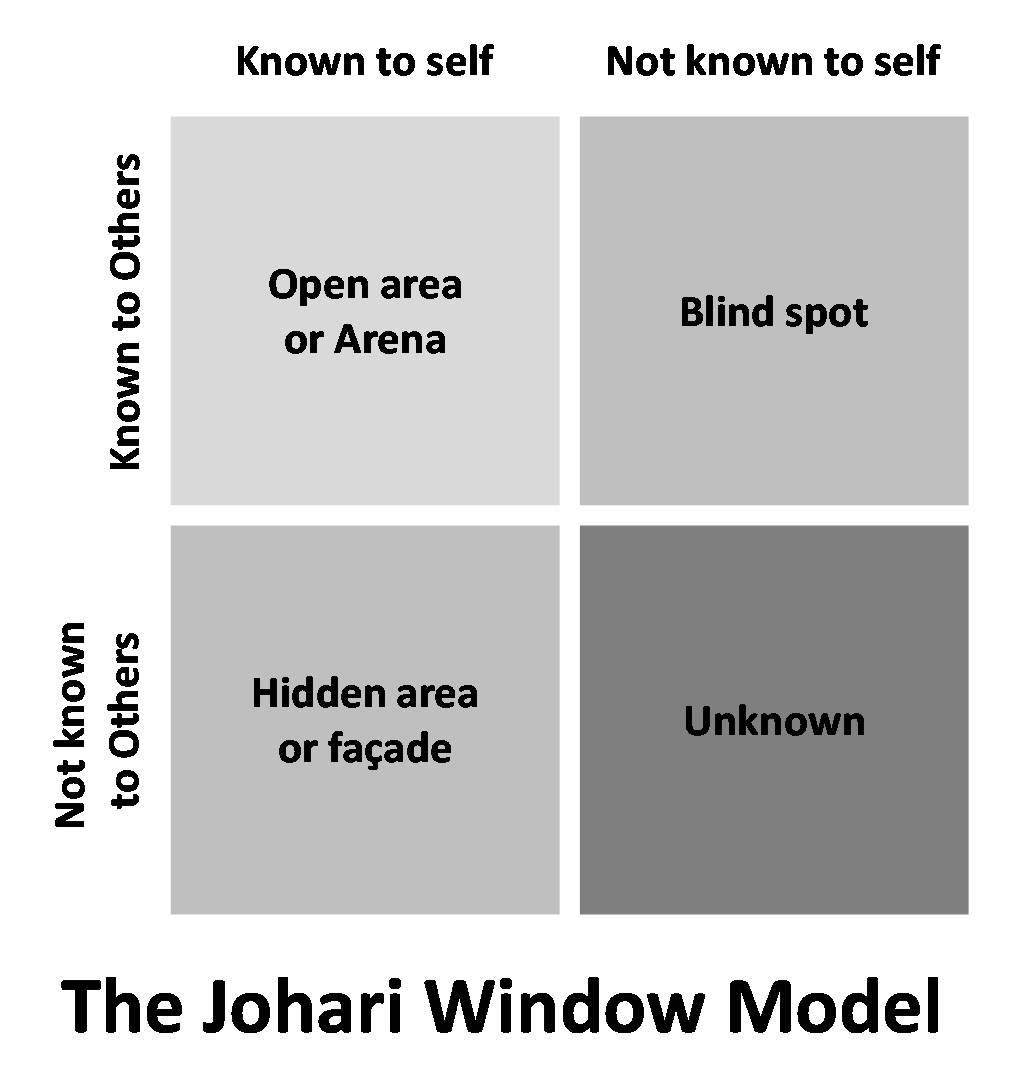Johari Window
The Basic Idea
Unless you are Professor X and can read people’s minds, it is likely that you rely on guesswork when it comes to understanding what other people think about you.
Unfortunately, that guesswork isn’t usually very accurate, largely not because we don’t understand other people, but because we do not really understand ourselves. As a result, a gap exists between our self-perception and other people’s perception of us, and it is a gap that we find difficult to identify.
The Johari Window can help diminish that gap. It is a self-awareness tool that helps us understand the differences between how people see us and how we see ourselves.1 The tool is based on the premise that our interactions with other people are based on these differing perceptions, and that when we have more aligned views with others, we will be able to have more effective and engaging interactions.1
There are known knows; there are things we know we know. We also know there are known unknowns; that is to say, we know there are some things we do not know. But there are also unknown unknowns – the ones we don’t know we don’t know.
– American politician and former United States Secretary of Defense, Donald Rumsfeld, in a 2002 news briefing.2
Theory, meet practice
TDL is an applied research consultancy. In our work, we leverage the insights of diverse fields—from psychology and economics to machine learning and behavioral data science—to sculpt targeted solutions to nuanced problems.
History
In 1955, psychologists Joseph Luft and Harry Ingham were researching group dynamics at the University of California. By studying how people in groups interacted with one another, the psychologists discovered that there was a disparity between how people thought others perceived them and how other people actually perceived them. They realized that the disparity was due to the fact that people do not know themselves well and find it difficult to accurately assess what components of their personality are known to others.

As a result, Luft and Ingham devised a self-awareness feedback loop tool so that group interactions could become more efficient. They named this tool the Johari Window, combining the first part of both of their first names (Joseph & Harry = Johari).3
The Johari Window is a four-square grid.3 The sections that comprise the window are
- Open Area: Known to Others & Known to Self
- Blind Spot: Know to Others & Not Known to Self
- Hidden Area: Not Known to Others & Known to Self
- Unknown: Not Known to Others & Not Know to Self
To use the Johari window, one would look at a list of characteristics (55 characteristics were used in the original model) and determine which five or six characteristics best represent their personality. Then, their peers would be given the same list of characteristics and asked which five or six they believed best represented their friend. All of the adjectives selected would then be compared.4
The characteristics or adjectives that are identified by both oneself and their peers would go into the ‘open area’. This category demonstrates what actions, behaviors, and characteristics are ‘public knowledge’.5
The characteristics that are identified by one’s peers, but not by themselves, would go into the ‘blind spot’ quadrant. This quadrant is especially useful for increasing one’s self- awareness, as it gives them insight into what others think about them that they do not themselves recognize. It most accurately describes the dissonance in perceptions and informs people what they need to work on.
The adjectives that are identified by oneself but not by any peers go into the ‘hidden area’ section. Sometimes, someone might actually want to keep these characteristics to themselves, if they are personal, but knowing what parts are hidden is still useful, as these might be characteristics you wish to divulge to someone you trust.5
The rest of the characteristics that no one selects go in the ‘unknown’ quadrant. If there are positive characteristics in this quadrant that you wish you embodied, it is useful to know that they are areas you need to work on.
When combined, the four quadrants give someone a comprehensive understanding of themselves and how people perceive them. Luft and Ingham believed that the more characteristics were in the ‘open area’ quadrant, the better group dynamics would be. To increase the size of that space, good communication and cooperation is required which enables more efficient inter-group development.6
While initially, the Johari Window focused on positive characteristics, later, another extensive list of negative traits was developed. It used the antonyms of the original list of 55 characteristics to give people insight into their personality flaws.4
In the 1950s, when Luft and Ingham first proposed this window, self-awareness had not really been a point of concern. Employers cared more about tangible, hard skills. However, as we’ve transitioned into a society that places greater emphasis on ‘soft skills’, like behavior, empathy and cooperation, the Johari window has become a very relevant and useful tool.6
Consequences
Self-development and self-awareness are areas that go hand-in-hand. Our level of self-awareness can really impact our interactions with others. Self-awareness is often thought to develop through stages, starting when we are only a child and increasing as we interact with the world around us. Since “self-recognition does not emerge suddenly, but develops gradually through a succession of types of behaviors” (44)7 using the Johari Window frequently to assess your strengths and weaknesses can help ensure that you get to know yourself better. Self-actualization, which comes about through self-awareness, is at the top of Maslow’s hierarchy of needs, and is thought to be necessary to find happiness.
The Johari Window can be used to see how your family, friends, coworkers and your superiors perceive you. It is likely that you reveal different parts of yourself to these different groups and therefore the results will look different.
The feedback tool might be especially useful in a work setting as it can help us assess how we are doing and how we might improve our performance. The Johari Window can be used by employers as a kind of review tool to let their employees know how they are doing. It might give you insight into why you weren’t picked for a promotion and what you need to work on to get your boss to associate more positive characteristics with you.
Being aware of what characteristics are in our blind spot and in our hidden area can also help diminish the Dunning-Kruger effect. The Dunning-Kruger effect suggests that we tend to overestimate our competence in areas where we lack information. By turning to our peers and seeing what it is they think we are good at, we might acknowledge that some characteristics that we believe belong in the ‘known to ourselves but not others’ category are untrue, and that the characteristics in our ‘blind spot’ are more accurate representations of ourselves. It can be difficult to see ourselves objectively, which is why the Dunning-Kruger effect exists, and the Johari Window can help with this.
The Johari Window is also a useful tool for leaders. By being more aware of how others receive our leadership, it becomes easier to adjust our actions and behaviors to be the kind of leader we want to be. People find it difficult to verbalize their feedback to their superiors, so the Johari Window can provide an anonymous tool through which leaders can get a truthful insight into how people perceive them.8
Controversies
There are a lot of different tools and techniques used to help groups work more efficiently. It is debatable whether self-awareness is the most important tool in group dynamics. A different model used to inform leadership strategies, the Hersey-Blanchard model, suggests that the abilities or characteristics that an individual is thought to embody are not the only important component in determining how effective group dynamics will be. The Hersey-Blanchard model suggests that a person’s willingness impacts someone’s performance, whereas the Johari Window does not take motivation into account.9
Another issue with the Johari Window is that, despite the fact that it is a tool to help increase self-awareness, it relies on a certain degree of self-awareness already. It requires someone to decipher what characteristics they believe best describes them. Since we tend to find it difficult to accurately understand ourselves, what we select may not be accurate. Other people might also have a skewed perception of ourselves. For example, the halo effect suggests a positive impression of a person can cloud our judgment and cause us to think every trait of theirs is positive. That may be why it is important to get a number of people to give you feedback with the Johari Window so you can see what commonalities exist across people’s perception of you.
The application of the Johari Window also has some ethical concerns, which might be extrapolated in the Nohari version of the tool. To hear the negative traits that your friends or coworkers think about you can be difficult and could actually do more damage than harm.10 Another concern is that the Johari Window ends up leading to a self-fulfilling prophecy. If someone learns that other people see them as lazy, they might internalize that and become lazy.
The Johari Window in Education
There are more and more people attending higher education institutions, which means that there now exists a more diverse pool of learners in colleges and universities. That also suggests there are more ‘non-traditional’ students.11 Unfortunately, higher education is becoming increasingly commodified, which can negatively impact the quality of learning. To counter this effect, personal and informed human interaction is needed.
Ricky Lowes, a lecturer at the University of Plymouth, using the Student Support System at her university as an example, suggests that the Johari Window can be a useful tool to mitigate the depersonalization of higher education that negatively impacts students’ learning and mental health. Lowes suggests that personalized tutoring, which can be informed by the window, is the path forward.11
Lowes identifies that a common complaint from students is that their tutor doesn’t really know them. This isn’t necessarily the tutor’s fault – it can be hard to really get to know someone when you only get to see them for a couple hours a week. Lowes proposes that tutors use student record systems as a base to fill out the Johari window, and then continue to add new characteristics as they get to know their students during sessions. Lowes believes this will have a positive impact on student learning, as “a tutor’s awareness of their tutee’s capabilities, interests and needs will clearly underpin their ability to support their tutee’s development” (6).11
Using the Johari Window can therefore give a tutor more insight into the needs and learning styles of their students and simultaneously inform them how well they know their students. If the hidden area is quite extensive, they may need to spend some more time getting to know their student before they can help them with specific material.
Identifying Postpartum Depression Using the Johari Window
Over 1 in every 7 women experience postpartum depression after childbirth.12 Postpartum depression is a mood disorder that makes it hard for new mothers to make it through the day. Despite its seriousness and its commonness, postpartum depression is often left undiagnosed. In fact, less than half of the cases of postpartum depression are identified in routine clinical assessment.13
Realizing an underdiagnosed issue, researchers decided to examine whether the Johari Window could help general practitioners (GPs), in collaboration with their patients, identify postpartum depression. General practitioners are often the doctors who conduct post-natal check-ups and are therefore in a good position to be able to identify postpartum depression.13
Since postpartum depression is a mental illness rather than a physical illness, it requires the patient to disclose their feelings, which is where the Johari Window can be useful. The researchers devised a version of the window with the following sections:
- Open area: the patients’ emotions and how they are coping are known to the GP and the patient.
- Blind spot: postnatal depression recognized by GP but not by patient.
- Hidden area: postnatal depression known to patient but not to the GP
- Unknown: postnatal depression unknown by both patient and GP.13
The researchers found that applying a tool that requires honest and open communication between patients and GPs could help mothers feel comfortable sharing their true feelings and make both the patient and the GP more attuned to what is going on.13 The Johari Window can therefore help practitioners more accurately identify when a patient is experiencing postpartum depression.
Related TDL Content
Optimism is Good For Many Things, But Not Pensions Savings
The optimism bias suggests that we overestimate the likelihood of good things happening and underestimate the probability of bad things happening. The bias can be applied to internal events too: we might overestimate our positive attributes and underestimate our negative ones, which is why the Johari Window is so useful for increasing our self-awareness. In this article, our writer Žiga Vižintin examines how the optimist bias negatively impacts our saving and spending habits. Greater self-awareness of our habits when it comes to money can help us better plan for our future.
Do High-Potential Employee Programs Work?
While sometimes, self-fulfilling prophecies have negative impacts, when the prophecy that is being fulfilled is a positive one, other people’s perception of us can positively impact our behavior. In this article, our writers Natasha Ouslis and Zad El-Makkaoui outline the Pygmalion Effect, which stipulates that someone’s positive expectations of us can cause us to perform better. The positive characteristics in the ‘blind spot’ of the Johari window – whether true or not – might therefore lead us to actualize these characteristics. Ouslis and El-Makkaoui demonstrate that high-potential employee programs help enact a positive self-fulfilling prophecy.
Sources
- The Johari Window: A Helpful Interpersonal Awareness Tool. (2020, October 12). The World of Work Project. https://worldofwork.io/2019/07/the-johari-window/
- Shermer, M. (2005, September 1). Rumsfeld’s wisdom. Scientific American. https://www.scientificamerican.com/article/rumsfelds-wisdom/
- The Johari Window Model. (2014, July 10). Communication Theory. https://www.communicationtheory.org/the-johari-window-model/
- Johari Window. (n.d.). Aston University. Retrieved March 22, 2021, from https://www2.aston.ac.uk/staff-public/documents/hr/OD/Johari%20window.pdf
- Discovering the 4 Panes of the Johari Window for 360 Degree Feedback. (2021, February 22). Explorance. https://explorance.com/blog/discovering-blind-spots-in-360-degree-feedback-with-the-johari-window/
- Johari Window Model and Free Diagrams. (2017, June 7). Business Balls. https://www.businessballs.com/self-awareness/johari-window-model-and-free-diagrams/
- Bertenthal, B. I., & Fischer, K. W. (1978). Development of self-recognition in the infant. Developmental Psychology, 14(1), 44-50. https://doi.org/10.1037/0012-1649.14.1.44
- Bolden, R. (n.d.). Leadership Development in Context. University of Exeter. https://www.researchgate.net/publication/29810621_Leadership_Development_in_Context
- Corporate Finance Institute. (2020, December 1). Hersey-Blanchard Model. https://corporatefinanceinstitute.com/resources/careers/soft-skills/hersey-blanchard-model/
- Winter, T. (2016, May 25). Praise & Criticism: Johari Window. Human Performance Technology by DTS. https://blog.dtssydney.com/praise-criticism-johari-window#
- Lowes, R. (2020). Knowing you: Personal tutoring, learning analytics and the Johari window. Frontiers in Education, 5(101), 1-11. https://doi.org/10.3389/feduc.2020.00101
- Postpartum Depression. (2008). American Psychological Association. Retrieved March 22, 2021, from https://www.apa.org/pi/women/resources/reports/postpartum-depression
- Sriranjan, A. N., Abrams, R., Wong, G., & Park, S. (2020). Towards an understanding of GPs’ viewpoint on diagnosing postnatal depression in general practice: A small-scale realist evaluation. Primary Health Care Research & Development, 21. https://doi.org/10.1017/s1463423620000316


